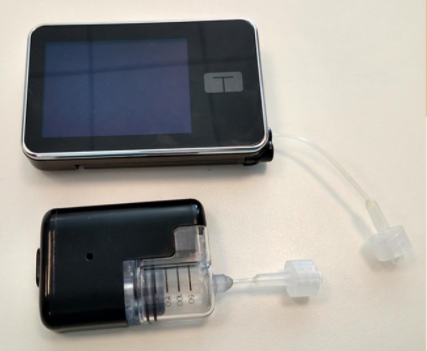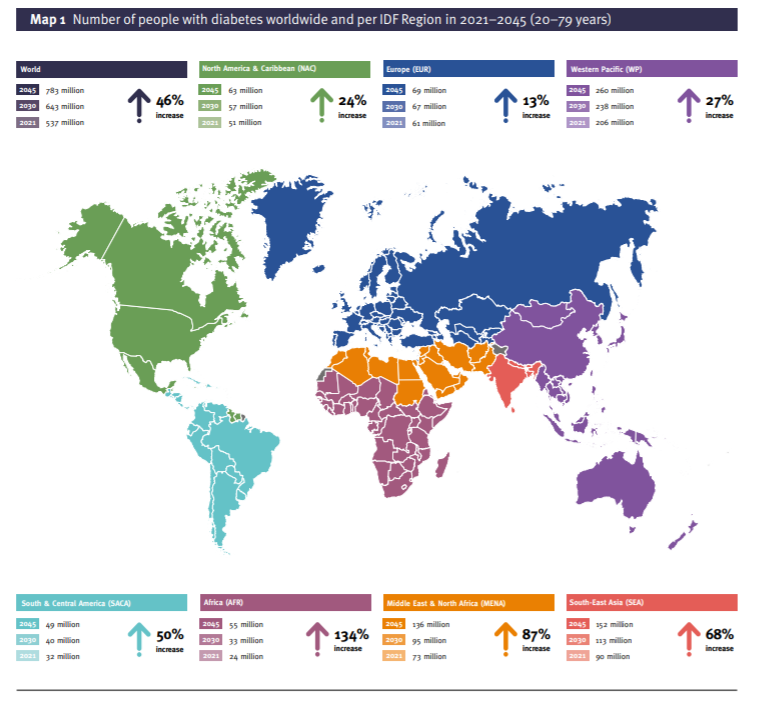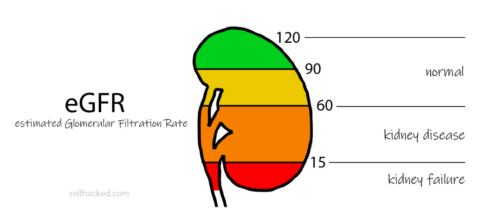Tandem Diabetes Care targets 1M customers by 2027 we reported by Ricky Zipp for MedTechDive.come, 7 December 2021.
 Tandem Diabetes Care projects that its worldwide customer base will triple to 1 million by 2027 as the insulin pump maker launches multiple new products and user growth is projected to jump over the next five years among both Type 1 and Type 2 diabetes patients. CFO Leigh Vosseller said Monday during a virtual R&D event that the company’s customer target will primarily come from capturing market share among Type 1 users as adoption by that specific population continues to grow. Tandem executives also said a group of new product releases and focusing more on Type 2 patients will help fuel the company’s growth projections.
Tandem Diabetes Care projects that its worldwide customer base will triple to 1 million by 2027 as the insulin pump maker launches multiple new products and user growth is projected to jump over the next five years among both Type 1 and Type 2 diabetes patients. CFO Leigh Vosseller said Monday during a virtual R&D event that the company’s customer target will primarily come from capturing market share among Type 1 users as adoption by that specific population continues to grow. Tandem executives also said a group of new product releases and focusing more on Type 2 patients will help fuel the company’s growth projections.
 Hitting 1 million installed units implies roughly $1.5 billion in sales by 2027, up from the approximately $700 million in sales the company has projected for 2021, Craig-Hallum analysts said in a Tuesday note. Despite the projected growth for insulin pumps and continuous glucose monitors, SVB Leerink analysts were more cautious on Tandem’s growth plans, giving rival Insulet the competitive advantage as the diabetes tech market develops.
Hitting 1 million installed units implies roughly $1.5 billion in sales by 2027, up from the approximately $700 million in sales the company has projected for 2021, Craig-Hallum analysts said in a Tuesday note. Despite the projected growth for insulin pumps and continuous glucose monitors, SVB Leerink analysts were more cautious on Tandem’s growth plans, giving rival Insulet the competitive advantage as the diabetes tech market develops.
Read more:
IDF Atlas: 1 in 10 Adults Worldwide Now Has Diabetes was reported by Miriam E. Tucker for MedScape.com, 7 December 2021. WOW!
 One in 10 adults worldwide currently has diabetes, accounting for an estimated global health expenditure of $966 billion in US dollars in 2021, according to the new International Diabetes Federation (IDF) Diabetes Atlas. The IDF Atlas, 10th edition, was published online December 6, 2021.
One in 10 adults worldwide currently has diabetes, accounting for an estimated global health expenditure of $966 billion in US dollars in 2021, according to the new International Diabetes Federation (IDF) Diabetes Atlas. The IDF Atlas, 10th edition, was published online December 6, 2021.
The Atlas also predicts increases in these numbers over the coming decades if current trends continue. “Our data and projections tell a sobering story. Diabetes prevalence is expected to increase globally. The number of adults with diabetes will rise from 537 million in 2021 to 786 million…by the year 2045, an increase of 46%. Rises are expected in every region of the world, with the largest increases expected to occur in the regions of Africa, the Middle East, and Southeast Asia,” said Atlas co-chair Dianna Magliano, PhD, head of diabetes and population health at the Baker Heart and Diabetes Institute, Melbourne, Australia.
Read more: IDF Atlas: 1 in 10 Adults Worldwide Now Has Diabetes
Some “Other” Stem Cell Research News:
Type 1 Diabetes Trial Tests Insulin-Secreting Implants Derived from Stem Cells was published by GenEngNews.com, 3 December 2021.
 For the first time, scientists have derived insulin-secreting pancreatic endoderm cells from human pluripotent stem cells (PSCs), grafted these cells into 26 patients with type 1 diabetes, and demonstrated insulin secretion. The ongoing multicenter clinical trial aims to test the safety, tolerability, and efficacy of the implants. These results constitute the first evidence of meal-regulated insulin secretion from implanted cells for over a year, although the insulin secreted by the implants did not have clinically relevant effects in the patients.
For the first time, scientists have derived insulin-secreting pancreatic endoderm cells from human pluripotent stem cells (PSCs), grafted these cells into 26 patients with type 1 diabetes, and demonstrated insulin secretion. The ongoing multicenter clinical trial aims to test the safety, tolerability, and efficacy of the implants. These results constitute the first evidence of meal-regulated insulin secretion from implanted cells for over a year, although the insulin secreted by the implants did not have clinically relevant effects in the patients.
“A landmark has been set. The possibility of an unlimited supply of insulin-producing cells gives hope to people living with type 1 diabetes,” said Eelco de Koning, PhD, of Leiden University Medical Center, and a co-author of a commentary on the study published in Cell Stem Cell. “Despite the absence of relevant clinical effects, this study will remain an important milestone for the field of human PSC-derived cell replacement therapies as it is one of the first to report cell survival and functionality one year after transplantation.”
The interim results of the trial appear in two articles published on December 2: “Insulin expression and C-peptide in type 1 diabetes subjects implanted with stem cell-derived pancreatic endoderm cells in an encapsulation device,” in the journal Cell Reports Medicine, and “Implanted pluripotent stem-cell-derived pancreatic endoderm cells secrete glucose-responsive C-peptide in patients with type 1 diabetes,” in the journal Cell Stem Cell.
Timothy Kieffer, PhD, professor at the University of British Columbia and senior author on the Cell Stem Cell paper said, “This work provides proof-of-concept for a stem cell derived insulin replacement in patients with type 1 diabetes. We show that lab-made pancreatic progenitors can survive and mature into cells capable of meal-regulated insulin production when implanted subcutaneously within macro-encapsulation devices. This is significant because it supports the idea that with further optimization, this approach can be used to free patients from the burden of daily insulin injections.”
Stem cell-based treatment produces insulin in patients with Type 1 diabetes was shared by the University of British Columbia, 2 December 2021.
 In the first study of its kind, a team of researchers at the University of British Columbia’s faculty of medicine and Vancouver Coastal Health (VCH) has helped to demonstrate that a stem cell-based treatment delivered through an implantable device can produce insulin in the human body. The treatment was provided to B.C. patients living with a severe form of Type 1 diabetes as part of a multi-year clinical trial. The study results were published today in Cell Stem Cell.
In the first study of its kind, a team of researchers at the University of British Columbia’s faculty of medicine and Vancouver Coastal Health (VCH) has helped to demonstrate that a stem cell-based treatment delivered through an implantable device can produce insulin in the human body. The treatment was provided to B.C. patients living with a severe form of Type 1 diabetes as part of a multi-year clinical trial. The study results were published today in Cell Stem Cell.
“Our findings demonstrate the incredible potential of this stem cell-based treatment. With further research, this treatment could one day eliminate dependence on insulin injections and transform the management of Type 1 diabetes,” said the study’s senior author Dr. Timothy Kieffer, professor in UBC faculty of medicine’s departments of surgery and cellular and physiological sciences, who was recently appointed as ViaCyte’s chief scientific officer.
“This work represents a major scientific breakthrough and demonstrates the critical role UBC and VCH are playing on the international stage to help find a cure for Type 1 diabetes through state-of-the-art research,” said Dr. David M. Thompson, the principal investigator for the study in Vancouver, director of the Vancouver General Hospital Diabetes Centre and clinical assistant professor in the UBC faculty of medicine’s division of endocrinology.
This study used levels of C-peptide—a short chain of amino acids that is released into the blood as a byproduct of the formation of insulin—as a measure of insulin release by the implanted cells. The researchers found C-peptide levels rose after patients ate a meal—evidence of normal functioning. Injected insulin does not generate C-peptide.
Read more: Stem cell-based treatment produces insulin in patients with Type 1 diabetes
Venom of cone snail could lead to future diabetes treatments was released by the University of New Hamshire and reported on ScienceDaily.com, 18 November 2021.
 The tapered cone shell is popular among seashell collectors for its colorful patterns, but the smooth mottled shells are also home to the cone snail which is capable of spewing a potent insulin-like venom that can paralyze its prey. Researchers at the University of New Hampshire have found that variants of this venom, known as cone snail insulin (Con-Ins), could offer future possibilities for developing new fast-acting drugs to help treat diabetics.
The tapered cone shell is popular among seashell collectors for its colorful patterns, but the smooth mottled shells are also home to the cone snail which is capable of spewing a potent insulin-like venom that can paralyze its prey. Researchers at the University of New Hampshire have found that variants of this venom, known as cone snail insulin (Con-Ins), could offer future possibilities for developing new fast-acting drugs to help treat diabetics.
Harish Vashisth, associate professor of chemical engineering said, “Our work found that the modeled Con-Ins variants, or analogs, bind even better to receptors in the body than the human hormone and may work faster which could make them a favorable option for stabilizing blood sugar levels and a potential for new therapeutics.”
In their study, recently published in the journal Proteins: Structure, Function, and Bioinformatics, researchers looked more closely at the cone snail venom which induces a hypoglycemic reaction that lowers blood sugar levels. Unlike insulin made in the body, the venom’s peptide sequence — which allows it to bind to human insulin receptors — is much shorter.
Read more: Venom of cone snail could lead to future diabetes treatments
Here’s what’s new on the Kidney Disease front
Raceless eGFR—Equation to Evaluate Kidney Function Will No Longer Include Race written by Natalie Sainz for diaTribeChange.org, 8 December 2021.
 The National Kidney Foundation and the American Society of Nephrology have created a new equation to measure kidney function. The “raceless eGFR” will work to address disparities among people with kidney disease, of which diabetes is the leading cause.
The National Kidney Foundation and the American Society of Nephrology have created a new equation to measure kidney function. The “raceless eGFR” will work to address disparities among people with kidney disease, of which diabetes is the leading cause.
The National Kidney Foundation (NKF) and the American Society of Nephrology (ASN) joint Task Force recommended that race not be considered in the estimated glomerular filtration rate (eGFR) — a measure to evaluate kidney function. This recommendation would reverse a long-standing practice. The Task Force outlined its recommendation in late September in a 55-page formal report. Prior to the new recommendations, eGFR was an estimated number that considered an individual’s creatinine level from a blood test as well as one’s age, sex, body type, and race. The higher the eGFR, the better the kidney function.
The NKF-ASN Task Force recommended “immediate implementation” of the raceless eGFR in all laboratories across the U.S. that includes increased use of a different blood marker, cystatin C, combined with blood creatinine, to generate the new measure. This decision was hailed by advocates and clinicians who have criticized the use of race in the equation. It will also better inform treatment decisions for Black individuals with diabetes and CKD.
Read more: Raceless eGFR—Equation to Evaluate Kidney Function Will No Longer Include Race
*****************************************************************************************************************************************
Do You Know Your Risk? Improve Your Awareness of Kidney Disease was reported by Matthew Garza and Andrew Briskin for diaTribe.org, 6 December 2021.
 Diabetes is the leading cause of chronic kidney disease (CKD) – affecting more than one-third of people with diabetes. However, research shows that some people with diabetes are unaware that they may be at risk for, or already have, early-stage CKD.
Diabetes is the leading cause of chronic kidney disease (CKD) – affecting more than one-third of people with diabetes. However, research shows that some people with diabetes are unaware that they may be at risk for, or already have, early-stage CKD.
Even though the ADA Standards of Care recommends annual screenings for CKD at a minimum, making sense of your kidney test results and knowing when to act can be difficult. The two common indicators of kidney health are your “urine albumin to creatinine ratio” (or UACR) and your “estimated glomerular filtration rate” (or eGFR). Each test is a different way to measure kidney function and damage, and the combination of the two numbers provides an accurate assessment. Making sure that everyone receives both of these key lab tests is particularly important when we look at data on people’s awareness of their risk and their treatment options.
Read more: Do You Know Your Risk? Improve Your Awareness of Kidney Disease
*****************************************************************************************************************************************
And then there is a new company, Journey Biosciences (www.journeybio.life).
 At Journey Biosciences we are dedicated to fundamentally improving diabetes care. Our mission is to provide people living with diabetes and their healthcare teams the diagnostic tools they need to assess their individual risk level for developing kidney complications associated with diabetes. We also deliver actionable insights for developing individualized care plans that minimize the progression of these complications.
At Journey Biosciences we are dedicated to fundamentally improving diabetes care. Our mission is to provide people living with diabetes and their healthcare teams the diagnostic tools they need to assess their individual risk level for developing kidney complications associated with diabetes. We also deliver actionable insights for developing individualized care plans that minimize the progression of these complications.
We know that people with diabetes are at greater risk for developing and experiencing the devastating effects that come with diabetes kidney disease (DKD). We also understand that managing blood glucose levels so that they remain in-range helps people with diabetes stay more healthy overall. But glycemic management (measured using the A1C test) doesn’t reliably show us who will or won’t develop complications. Some people develop chronic kidney disease (CKD) despite maintaining “tight control.” While others with a history of higher glucose levels remain complication-free. Decades can pass before any sign of kidney damage shows itself.
 The science behind our proactive diagnostic screening product is based on data collected as part of the most comprehensive longitudinal diabetes outcome studies done to-date (including the Natural History of Diabetic Nephropathy Study and Pima Indians studies and confirmed by the DCCT/EDIC and ACCORD Studies.) By matching blood biomarkers present with actual health outcomes documented in these studies, our Chief Scientific Officer Dr. Paul Beisswenger, MD and his research team uncovered strong correlations between the amount of advanced glycation end products (AGEs) in the blood of people with diabetes and their individual risk levels for developing kidney disease.
The science behind our proactive diagnostic screening product is based on data collected as part of the most comprehensive longitudinal diabetes outcome studies done to-date (including the Natural History of Diabetic Nephropathy Study and Pima Indians studies and confirmed by the DCCT/EDIC and ACCORD Studies.) By matching blood biomarkers present with actual health outcomes documented in these studies, our Chief Scientific Officer Dr. Paul Beisswenger, MD and his research team uncovered strong correlations between the amount of advanced glycation end products (AGEs) in the blood of people with diabetes and their individual risk levels for developing kidney disease.
Read more: Former EdgePark VP Ventures Out to Help People with Diabetes Detect Kidney Risk
The changing character of diabetes complications was shared by Srikanth Bellary for The Lancet.com/Diabetes&Endocrinology, 30 November 2021.
 Several factors influence the course of a chronic disease such as diabetes, including our understanding of the disease epidemiology, public health initiatives, and the introduction of new therapies and interventions. The cumulative effect of these factors is best studied by observations made over long periods of time. Although randomised controlled trials and long-term follow up of well-defined cohorts have been the gold standard, the availability of large and well-established databases has emerged as an alternative way to study the long-term trends of chronic conditions.
Several factors influence the course of a chronic disease such as diabetes, including our understanding of the disease epidemiology, public health initiatives, and the introduction of new therapies and interventions. The cumulative effect of these factors is best studied by observations made over long periods of time. Although randomised controlled trials and long-term follow up of well-defined cohorts have been the gold standard, the availability of large and well-established databases has emerged as an alternative way to study the long-term trends of chronic conditions.
For the majority of the last century, diabetes-related hospitalisations have been largely driven by hyperglycaemic and non-hyperglycaemic crises and vascular complications. Recent evidence, however, suggests that this trend is changing and there is a new pattern emerging. In The Lancet Diabetes and Endocrinology, Johnathan Pearson-Stuttard and colleagues present their findings from a retrospective data analysis study looking at trends in the cause-specific hospitalisations attributable to diabetes over a 16-year period.
The study found that traditional diabetes complications (vascular and non-hyperglycaemic crises) declined from 60% of all hospitalisations studied in 2013 to 30% in 2018, and non-traditional complications such as infections and cancer increased substantially during the same period. Vascular complications, amputations, and diabetes crises that accounted for almost half of all hospitalisations in 2003 declined to only a third of diabetes-related hospitalisations in 2018. Among the diabetes related complications, the largest reductions in hospitalisation were observed for major amputations (65–75%) and non-hyperglycaemic crises (55–65%), and hospitalisation for hyperglycaemic crises saw an increase. Interestingly, the decline in hospitalisation rates for ischaemic heart disease, myocardial infarction, stroke, and major amputations was not uniform throughout the study period with greater reductions seen during the earlier years and flattening of the trend during the latter part of the study. Among the non-traditional causes, biggest increases in rates of hospitalisation were seen due to sepsis (in women), which increased by 651·4% (from 13·8 hospitalisations per 10 000 women in 2003 to 103·7 hospitalisations per 10 000 women in 2018, along with large increases in hospitalisations for respiratory infections and cancers, particularly non-diabetes related cancers.
The diversification of the causes of hospitalisations seen in this study provide important insights into the changing character of diabetes complications.
Read more: The changing character of diabetes complications
BD finalizes name (Embecta) and leadership for its billion-dollar diabetes spinoff, as reported by Conor Hale for FierceBioTech.com, 6 December 2021.
 BD has settled on a new name for its new company, the independent spinout that will house its billion-dollar diabetes care business. Embecta is set to launch as its own, publicly traded brand in the second quarter of 2022 after almost a century of supplying a portfolio of insulin pens and syringes under the BD banner.
BD has settled on a new name for its new company, the independent spinout that will house its billion-dollar diabetes care business. Embecta is set to launch as its own, publicly traded brand in the second quarter of 2022 after almost a century of supplying a portfolio of insulin pens and syringes under the BD banner.
Striking out on its own will give Embecta the chance to seek out its own acquisitions while enabling BD to do the same through its ongoing tuck-in dealmaking strategy. Carrying over the “bect” in its logo as a nod to Becton, Dickinson and Company, Embecta will maintain manufacturing sites throughout the U.S., Ireland and China that have produced around 8 billion injection devices annually. Its headquarters will be in New Jersey and Massachusetts.
Read more: BD finalizes name and leadership for its billion-dollar diabetes spinoff


Last month I had to have my left kidney removed, so with all the kidney coverage of late, it makes me appreciate more and more how important our kidneys are. Of course, I could also start breeding snails.
rick